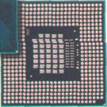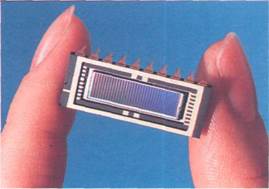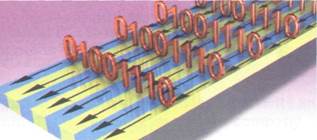What is inside a PC system?
Processing
The nerve centre of a PC is the processor, also called the CPU, or central processing unit. This is built into a single chip which executes program instructions and coordinates the activities that take place within 5 the computer system. The chip itself is a small piece of silicon with a complex electrical circuit called an integrated circuit.
The processor consists of three main parts: ш The control unit examines the instructions in 10 the user's program, interprets each instruction and causes the circuits and the rest of the components - monitor, disk drives, etc. - to execute the functions specified.
■ The arithmetic logic unit (ALU) performs
is mathematical calculations (+, etc.) and logical operations (AND, OR, NOT).
■ The registers are high-speed units of memory used to store and control data. One of the registers (the program counter, or PC) keeps track
20 of the next instruction to be performed in the main memory. The other (the instruction register, or IR) holds the instruction that is being executed (see Fig. 1 on page 13).
The power and performance of a computer is partly 25 determined by the speed of its processor. A system clock sends out signals at fixed intervals to measure and synchronize the flow of data. Clock speed is measured in gigahertz (GHz). For example, a CPU running at 4GHz (four thousand million hertz, or 30 cycles, per second) will enable your PC to handle the most demanding applications.
| j (jntel) |

|
The Intel Core 2 Duo processor; other chip manufacturers are AMD and Motorola
RAM and ROM
The programs and data which pass through the processor must be loaded into the main memory in order to be processed. Therefore, when the user runs a program, the CPU looks for it on the hard disk and transfers a copy into the RAM chips. RAM (random access memory) is volatile - that is, its information is lost when the computer is turned off. However,
ROM (read only memory) is non-volatile, containing 40 instructions and routines for the basic operations of the CPU. The BIOS (basic input/output system) uses ROM to control communication with peripherals.
RAM capacity can be expanded by adding extra 45 chips, usually contained in small circuit boards called dual in-line memory modules (DIMMs).

|
| ARAM chip |
Buses and cards
The main circuit board inside your system is called the motherboard and contains the processor, the memory chips, expansions slots, and controllers so for peripherals, connected by buses - electrical channels which allow devices inside the computer to communicate with each other. For example, the front side bus carries all data that passes from the CPU to other devices.
55 The size of a bus, called bus width, determines how much data can be transmitted. It can be compared to the number of lanes on a motorway - the larger the width, the more data can travel along the bus. For example, a 64-bit bus can transmit 64 bits of data.
60 Expansion slots allow users to install expansion cards, adding features like sound, memory and network capabilities.
A data bus

|
«Inside the system
Central processing unit (CPU)
Control unit
| Г |
| bus |
Arithmetic logic unit (ALU)
| R | |||||||
| PC |
| Registers |
| Main memory | |||||||||
Fig. 1: Organization of a simple computer; the CPU is built into a single microprocessor chip
Language work: defining relative clauses
Look at the HELP box and then complete the sentences below with suitable relative pronouns. Give alternative options if possible. Put brackets round the relative pronouns you can leave out.
1That's the computer............................... I'd like
to buy.
2Core 2 Duo is a new Intel processor
__________________ contains about 291 million
transistors.
3A webmaster is a person__________________
designs, develops and maintains a website.
A bus is an electronic pathway
.............................. „carries signals between
computer devices.
Here's the DVD.............................. you lent me!
Last night I met someone...............
works for GM as a software engineer.
Defining relative clauses
• We can define people or things with a defining (restrictive) relative clause. We use the relative pronoun who to refer to a person; we can also use that.
A blogger is a person who/that keeps a web log (blog) or publishes an online diary.
• We use the relative pronoun which (or that) to refer to a thing, not a person.
This is built into a single chip which/that executes program instructions and coordinates the activities that take place within the computer system.
• Relative pronouns can be left out when they are the object of the relative clause.

|
| • l»J |
The main circuit board (which/that) you have inside your system is called the motherboard...
How memory is measured
Read the text and then answer these questions.
1 How many digits does a binary system use?
2 What is a bit?
3 What is a collection of eight bits called?
4 What does ASCII stand for?
5 What is the purpose of ASCII?